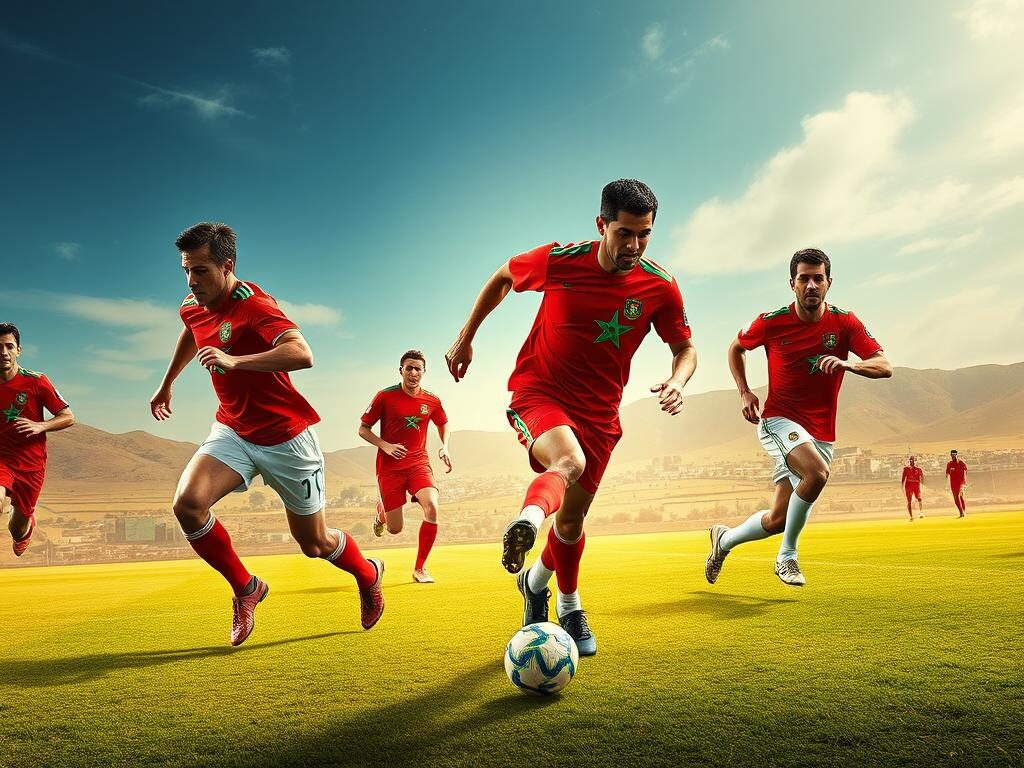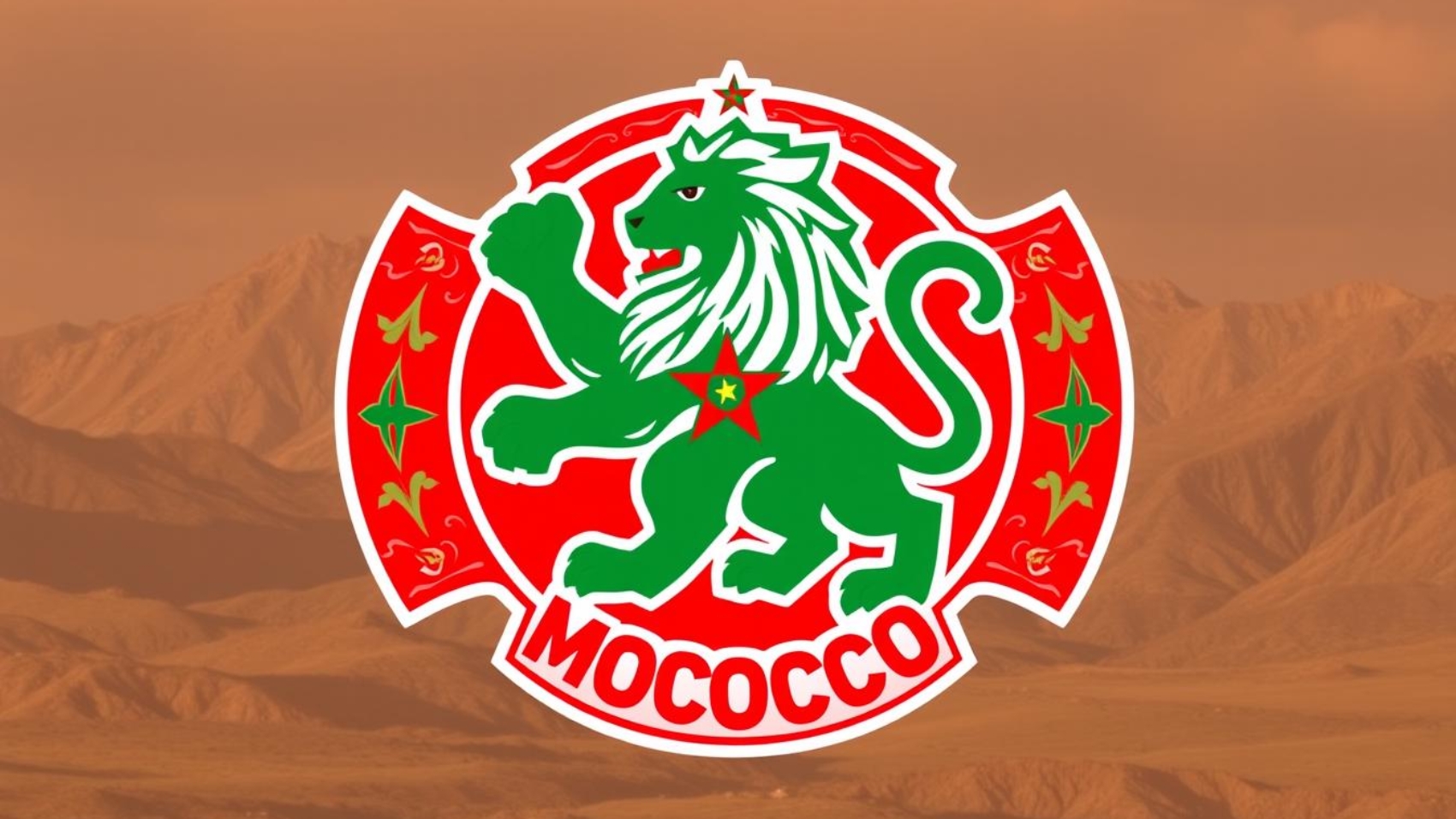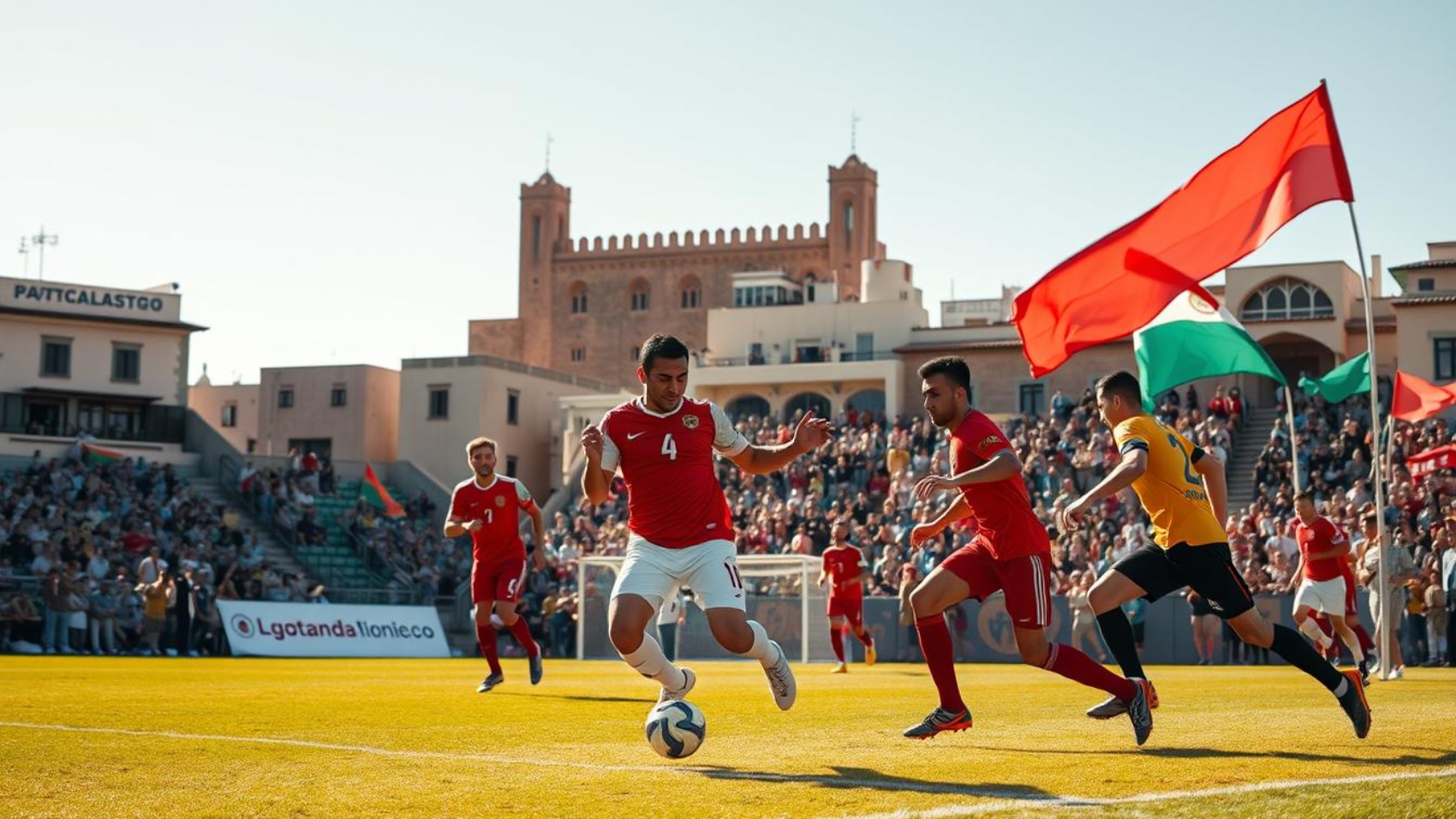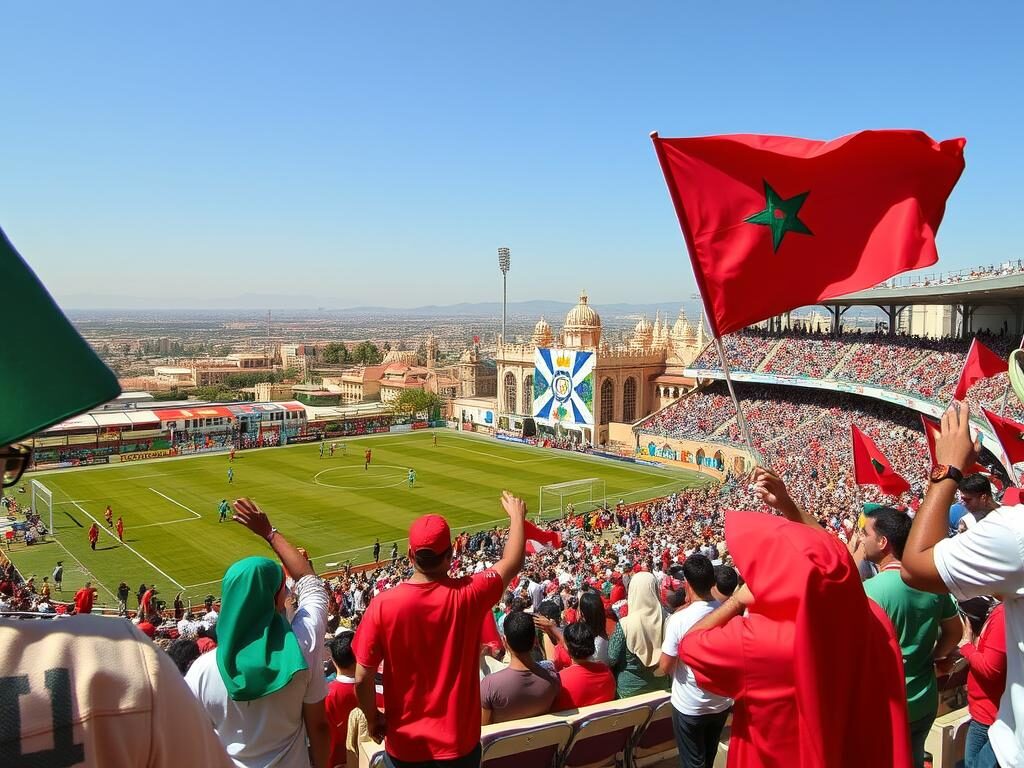The Moroccan national team, known as the Atlas Lions, is a source of pride for fans. It was formed in 1956 after Morocco gained independence. The team’s history is filled with perseverance and passion.
This section explores the team’s origins and key performances. It also looks at the lion emblem, which represents strength and courage. These values are important in sports and Moroccan culture.
Introduction to the Atlas Lions
The Atlas Lions, the nickname for the Moroccan national team, is loved by fans everywhere. They represent the rich history of Morocco soccer. The team’s colors, red and green, show the nation’s pride and identity.
The Atlas Lions have seen ups and downs over the years. Each game is filled with excitement and passion. Their unique playing style is a mix of skill, strategy, and teamwork.
The team’s image is shaped by Moroccan culture. They are more than athletes; they are symbols of Moroccan heritage. Competing in big tournaments, they inspire many, both in Morocco and around the world.
The Formation of the Moroccan National Team
The Moroccan national team started soon after Morocco gained freedom from France in 1956. The Moroccan Football Association took charge, overseeing soccer in the country. They helped the team grow in a changing sports world.
The Morocco football association is key in finding and growing local talent. They hold national competitions where players can show their skills. Early on, the team faced challenges like poor facilities and limited resources.
But the team and the association didn’t give up. They focused on young players and partnerships, building a strong base. Good governance helped the team stay competitive worldwide.
Key Achievements of Morocco Soccer
The Moroccan national soccer team, known as the Atlas Lions, has a rich history. They have made significant contributions to soccer. From their first FIFA World Cup appearance to their wins in regional tournaments, Morocco’s achievements are impressive.
Historic World Cup Performances
Morocco’s soccer journey started in the 1970 FIFA World Cup. This was a significant moment in their history. In the 1986 World Cup in Mexico, they became the first African team to reach the knockout stage.
Regional Tournaments and Championships
The Atlas Lions have also done well in regional competitions. Their success in the Africa Cup of Nations shows their strength. Morocco has consistently done well in this tournament, winning games and making unforgettable moments.
Morocco Football Association: Governance and Structure
The Moroccan Football Association, known as FRMF, is key in soccer development in Morocco. It oversees soccer from the grassroots to the national team. The FRMF’s structure ensures good governance and direction for Moroccan soccer.
FRMF has committees for competition management, player development, and women’s soccer. These groups work together for a smooth operation. The association also supports training programs for young talent, giving athletes the tools to excel.
- Management of national competitions and leagues
- Implementation of youth soccer programs
- Promotion of diversity through women’s soccer initiatives
The Moroccan Football Association also works to increase the national team’s global presence. It partners with international groups, joins global events, and strengthens club ties. These actions help Morocco shine on the world soccer scene and promote excellence in soccer.
Notable Moroccan Players Over the Years
Moroccan players have made a big impact on football. They have shown their talent and hard work over the years. This section looks at both current stars and legendary players who show the best of Moroccan soccer.
Current Stars of the Moroccan Soccer Team
Hakim Ziyech and Achraf Hakimi are among the top players for Morocco today. Ziyech is known for his amazing playmaking skills. He is key for his club and the national team.
Achraf Hakimi is a standout defender with great attacking skills. He has made a big name for himself in top European leagues. Young talents like Youssef En-Nesyri and Samy Mmaee are also making a big impact for the national team.
Legendary Figures in Moroccan Football History
The legacy of Moroccan soccer stars goes beyond today’s players. Abdeljalil Hadda and Salah Eddine Bassir were trailblazers. Hadda was a goal-scoring forward who played a crucial role in the 1990s.
Bassir was known for his skillful dribbling and vision. His achievements still inspire young players today. Their legacies continue to motivate the next generation of Moroccan footballers.

Moroccan National Team’s Playing Style
The Moroccan national team’s style is rich and focused on attacking football. It combines technical skill, quick moves, and a unique tactical plan. Players use their speed to open up chances.
Over time, the team’s style has grown, mixing new tactics with old traditions. Coaches aim for flexibility, changing formations to match opponents’ strengths. They often use the 4-3-3 and 4-2-3-1 formations for balance.
This approach lets players show their creativity while working together. It makes the team exciting to watch and successful in games.
In summary, the Moroccan team’s love for attacking football, backed by a solid strategy, shows their promise on the world stage.
Impact of Moroccan Culture on the Team
Moroccan culture deeply affects the national soccer team’s identity and performance. It influences everything from music to traditional values. This creates a special atmosphere that boosts players’ mental strength during games.
Community and family ties are key in Moroccan soccer traditions. Players find inspiration in their roots, building a strong sense of unity and teamwork. This unity helps them perform with pride and honor, leading to their success.
The team’s spirit is shaped by Morocco’s rich history and traditions. Players often celebrate victories with grand festivities and use motivational chants before games. These practices reflect the values of Moroccan society.
This mix of athletic skill and cultural identity makes the team stand out on the international stage. It shows that being part of a team is more than just playing soccer; it’s about honoring your heritage.
Challenges Faced by the Morocco Soccer Team
The Moroccan national soccer team has made great strides, but they face many challenges. These issues can come from different places and affect how well the team works together.
One big problem is team obstacles. These include changes in management that can shake up the team’s plans. When coaches change often, it’s hard for players to adjust to new ways of playing.
Another issue is the pressure from fans. Fans have high hopes for the team, which can stress out the players. When the team doesn’t meet these expectations, it can be tough.
Also, injuries are a big problem. They can keep key players from playing, which affects the team’s strength. This makes it hard to compete against strong teams. International games add to the challenge, with fierce rivalries.
- Challenges from frequent managerial changes.
- High expectations from fans creating added pressure.
- Impact of injuries on key player availability.
- Increased competition from other national teams.
Morocco World Cup Aspirations
The Moroccan national team aims to grow its role in international soccer. They want to qualify for future World Cups and improve soccer development in Morocco. Building a strong foundation is key to growing talent and performing well globally.
Future Goals and Strategies
To reach these goals, the team has set several key objectives:
- Starting youth training programs to find and grow young talent.
- Improving domestic leagues to make them more competitive.
- Working with international clubs to share knowledge and expose players.
These plans show the team’s dedication to excellence and success over time.
Fan Engagement and Support
Fan support is vital for the team’s success. It boosts morale and builds a community around the team. Initiatives include:
- Inviting fans to join local soccer events and training camps.
- Using social media to connect and talk to followers.
- Starting community programs to grow grassroots support.
By focusing on fan support, the team can unite the community and reach its ambitious goals.
Conclusion
The Moroccan national team, known as the Atlas Lions, is more than just a soccer team. They symbolize the rich culture and unity of Morocco. Their achievements in tournaments and competitions show their strength and pride.
The future looks bright for the Atlas Lions. They have a mix of new and experienced players. This team is ready to make a mark in soccer, with fans cheering them on.
In summary, the Moroccan national team’s story is one of hope and dreams. They face challenges but are dedicated to being the best. Their journey in soccer is inspiring and will continue to be a force to be reckoned with.
FAQ
What is the history of the Moroccan national team?
The Moroccan national team, known as the Atlas Lions, started in 1956. This was after Morocco gained freedom. They have shown great talent and resilience in international soccer.
How does the Moroccan Football Association support the national team?
The Moroccan Football Association (FRMF) helps a lot. They develop local talent, manage national competitions, and handle international games for the team.
What are some key achievements of the Morocco soccer team in World Cups?
Morocco first played in the World Cup in 1970. They were the first African team to get past the group stage in 1986. These moments show Morocco’s big role in soccer.
Who are some notable Moroccan players currently playing?
Stars like Hakim Ziyech and Achraf Hakimi are making a big impact. They play well for their clubs and the Moroccan team.
What is the playing style of the Atlas Lions?
The team is known for their attacking play, skill, and speed. They use their speed on the sides to be dynamic on the field.
How does Moroccan culture influence the national soccer team?
Moroccan culture, including music and art, shapes the team’s identity. It helps players stay united and focused during games.
What challenges has the Morocco soccer team faced?
The team has faced many challenges. These include ups and downs in performance, changes in management, and fan pressure. These issues affect their success.
What are Morocco’s future aspirations for the World Cup?
The team wants to do well in future World Cups. They aim to build a strong soccer base and connect with fans through programs and social media.




